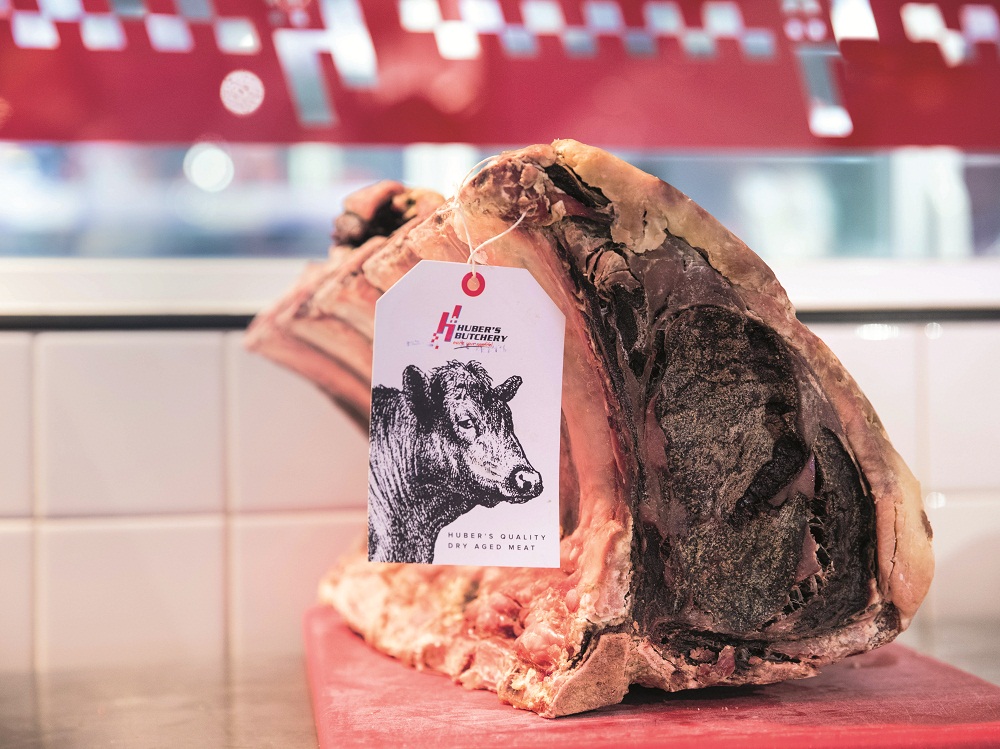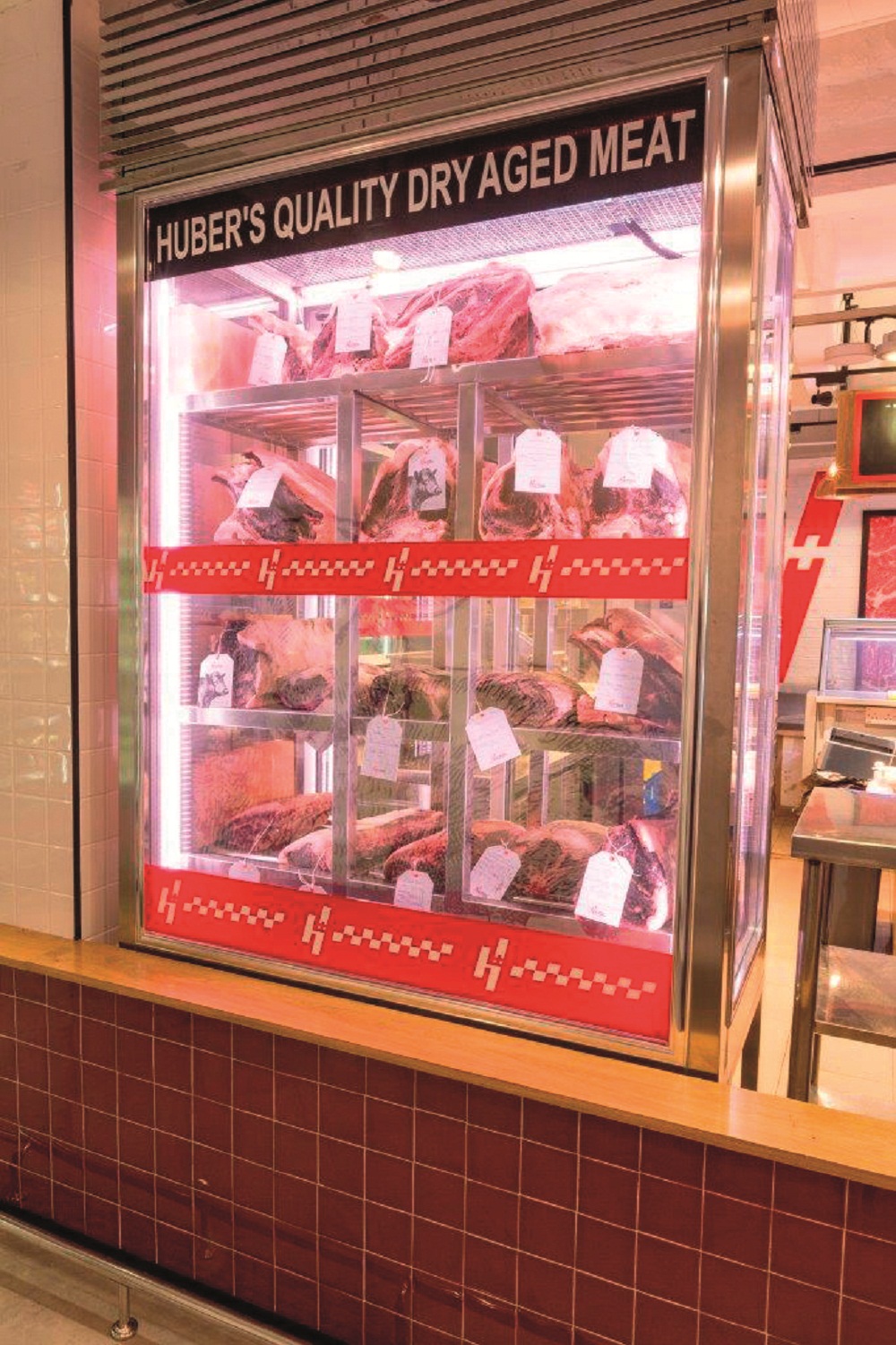They say the finer things in life improve with age. Here’s a glimpse into the world of dry-aged beef and what it really means.

Dry ageing concentrates the flavours of beef, leaving it typically described as tasting nuttier, muskier, like mushrooms and blue cheese. Natural enzymes and bacteria within the meat start to break down its molecular bonds when exposed to oxygen, altering the flavor and texture of the protein. Before a cut of dry-aged beef can be used for cooking, the rotten crust that forms around the meat’s surface has to be carved out.
Interesting then, that a lesser yield comes with a higher price tag. “Dry ageing is essentially a controlled decomposition,” says Andre Huber, executive director of Huber’s Butchery. In Singapore, dry-aged beef is expensive because land space and rental is expensive, as the meat is sitting in a dedicated ageing chamber (or room) for 30 to 60 days with closely monitored temperature, humidity, and air flow. Dryaged beef is best done using Himalayan salt blocks in a room that is food safe, has good air circulation and promotes the growth of good bacteria while preventing bad bacteria and mould from growing.
At Huber’s Butchery, dry ageing is done in a slow, controlled process. “We take about 60 days to age what others would usually do in 28 days because we believe the slower process is safer and yields beef with better flavour and texture,” explains Huber. The company has a customised dry-ageing programme that allows customers to order various cuts of meat and dictate how long they would like it to be dry-aged for. “Some customers request for beef to be aged for an extended period of time like 100 days or even 200 days. People believe it will get better with age, like how it usually is with wine. However for me, there is a point where the beef flavour just gets too funky and very few people will enjoy that flavour.” Most restaurants sell beef aged up to 45 days only because any longer, the flavour becomes too funky for diners to appreciate.
Huber goes on to say that aged meat comes in two forms – wet-aged and dryaged. “Both versions involve enzymes breaking down the meat which results in beef that is more flavourful and softer.” As carbohydrates turn into sugars, they weaken the connective tissue around the protein strands so that the meat becomes more tender and sweet. Meanwhile, as the water inside the meat works its way out, the meat begins to shrink and flavours begin to concentrate.
In comparison, wet-aged describes meat that has been aged in a vacuumsealed plastic bag for months that prevents evaporation from taking place. This method results in less concentrated flavours, without the nutty flavour or same mouthfeel as a dry-aged steak. Dry-aged meat has the addition of moisture loss as well as possible good bacteria growing on the meat that adds an additional flavor profile to the beef.
.jpg)
“You have to start with a good quality product,” said Huber. “You need meat that has a higher fat content in terms of marbling so that it will keep sufficiently moist even after the dry-ageing process. It is important to choose premium quality large cuts with fat caps and bone-in to protect the sides of the meat during dry ageing. By having a thick cap on its exterior, will ensure that only fat is lost during trimming at the end of the ageing process.”
Huber says that a good Angus 200+ day grain fed beef is best. “The long grain feeding gives the beef a good amount of marbling and the fat has a sweetness that helps to balance the dry-aged flavours. An alternative beef we have is a Galician style grass fed cow that is typically older than six years of age, compared to most commercial beef that is slaughtered at two to three years of age. By allowing the cow to graze of prime grasslands, the cattle develop a good amount of marbling, and because the animal is older, the flavour of the meat is also more intense.”
Naturally, the longer the beef is dryaged, the more intense and pronounced its flavours. The aged flavour varies according to length of ageing as well as the aging conditions. “For beef that is typically aged from 14 to 30 days, there is a concentration of beef flavour; from 30 to 60 days, there is a concentrated beef flavour with a development of slight blue cheese, nutty flavours from the good bacteria; and after 60 days, the funky taste starts developing and gets more intense as time passes. These are the results in our dry-ageing room. For other company or people ageing beef, the temperature, humidity or air flow may be different hence the ageing process could be very different,” shares Huber. “There are many others way such as wrapping the beef in fat, butter or with whisky but I prefer to have it naturally dry aged. Also there is the trend to age the beef with all kinds of alcohol, whisky, sake or using butter or tallow.”
